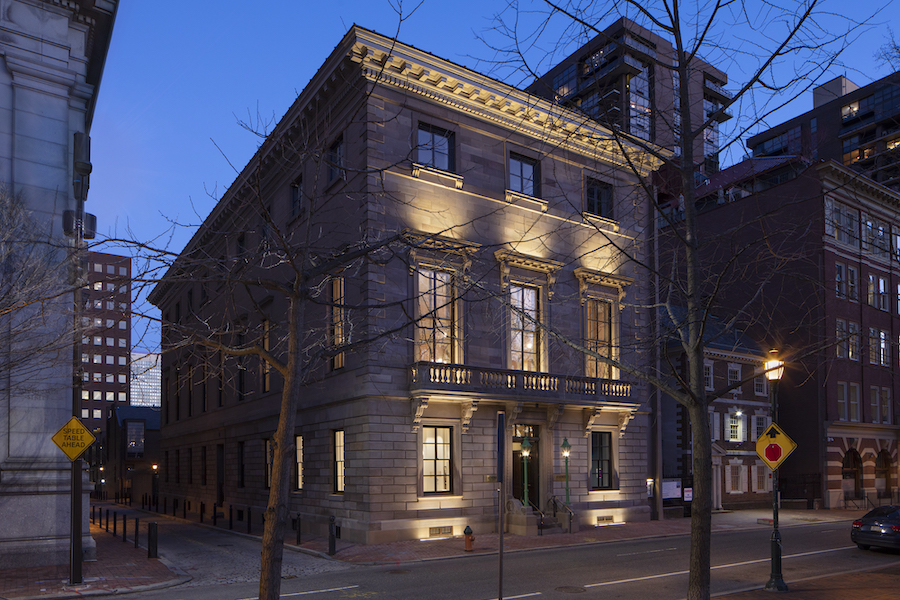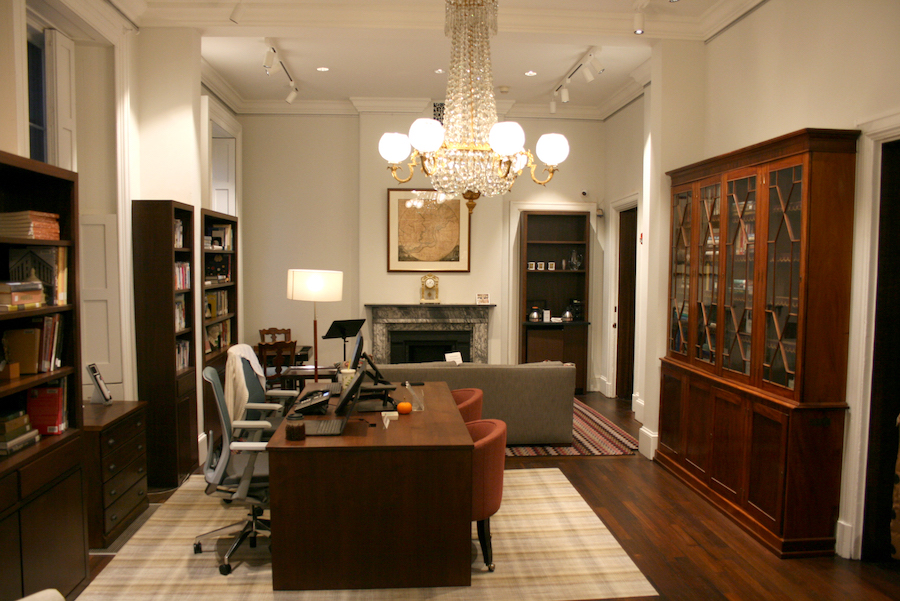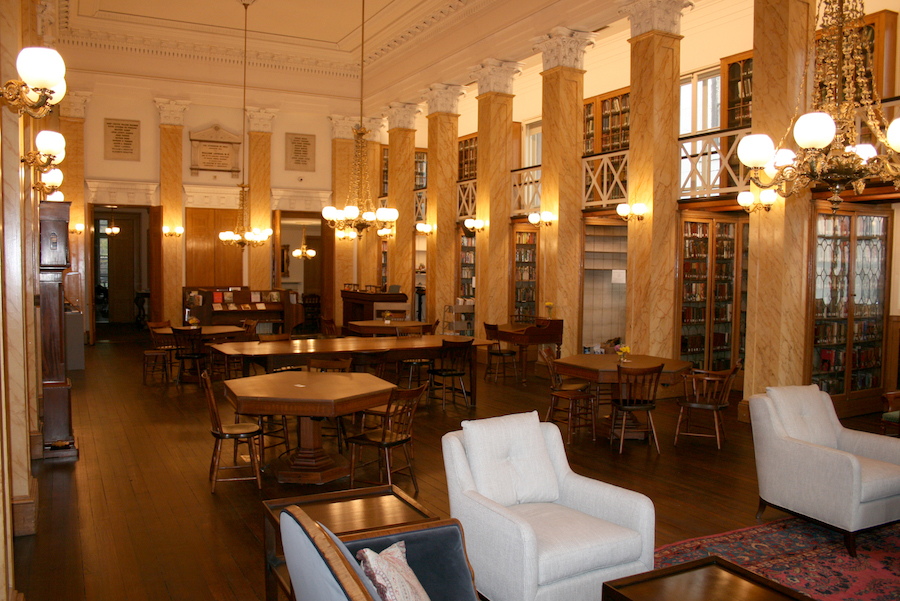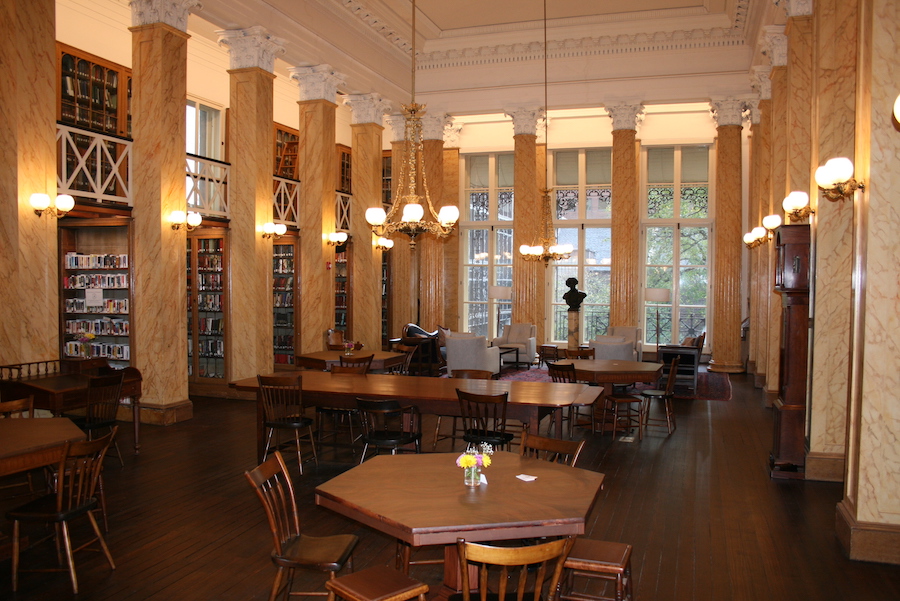A Historic Philly Library Gets a Facelift – And Then Some
The 208-year-old Athenaeum of Philadelphia gave its home a 175th birthday present that brought it into the 21st century while making it look more like itself.

Architect John Notman’s 1847 home for the Athenaeum of Philadelphia is one of the first buildings in the city built out of brownstone. In equipping it for the way research libraries function in the 21st century, it also saved its 19th-century soul. Lighting designed by Mark Hoyer showcases it after dark. / This photo: Joseph Elliott via the Athenaeum of Philadelphia; all others courtesy the Athenaeum
Although the tax-supported free public library as we now know it didn’t come into existence until 1833, Philadelphia and its environs played a major role in the development and spread of libraries in the United States. It’s home to the first subscription library in America, the Library Company of Philadelphia, founded by Benjamin Franklin in 1731; the oldest library open to the public in the country, established in Darby in 1743; and several specialized libraries focused on various subjects.
One of those libraries, the Athenaeum of Philadelphia, is a relative latecomer to the subscription-library field; it was established in 1814. But as a repository of architectural literature and history, it has few peers in the United States. Fans and scholars of Philadelphia architecture, including this writer, use the Philadelphia Architects and Buildings online database, which it maintains. And even though the library is a membership organization, many non-members attend exhibitions, receptions and other events held in its halls. “Last year, we had 122 programs, all told, and almost all of them were open to the public,” says Beth Hessel, the Athenaeum’s executive director.
Non-members can even use the Athenaeum’s collections for their own research with advance reservations, and the institution has welcomed notable “strangers” from all over the world who have come to explore its collections over the decades.
Its building is a notable architectural landmark itself. Designed by architect John Notman in 1847, it is considered the first American building in the Italianate style, and it’s also one of the first buildings in the city made of brownstone.
All that use wears a building down, though, and the Athenaeum has indeed gotten periodic updates and makeovers over the years. But when the library’s management decided it was time for another one in 2017, they decided they also needed to rethink how the building’s interior spaces functioned and served those diverse groups.
“Philadelphia and our community had changed a lot since 1993,” the last time the Athenaeum got a major makeover, says Hessel. So the Athenaeum engaged architecture firm KieranTimberlake in 2017 to produce a master plan for the building’s next renewal.
The actual work of rebuilding began in 2021. The original game plan was to do the bulk of the rebuilding along with a restoration of the building’s exterior and close the building for the summer, a time when it was lightly used.
But the COVID lockdown and the supply-chain issues that arose when the lockdown ended threw the timeline off and raised the project’s cost. So the Athenaeum board went back to the drawing board, made some tweaks to the rebuild to trim costs, and produced a revised project with a completion target of October 2022, the 175th anniversary of the building. The Athenaeum closed on Memorial Day 2022 for the interior and exterior renovations, and reopened the first week in November.
The renovations both improved and increased the space devoted to exhibits and provided members with a more comfortable place to relax.

The street-facing side of the new members’ lounge
A small office, the old welcome desk and a room that had housed a collection of items belonging to Joseph Bonaparte to the left of the front entrance were combined to form a new members’ lounge. This bright space now contains the library’s periodicals, a welcome desk and two seating areas. It also has a coffee-and-tea station that has proved popular with members.

A fireplace and a coffee-and-tea station are located at the back of the lounge
The new members’ lounge is about twice the size of the old one that had been located further back on the first floor. It also contains the chandeliers that had hung in the exhibition gallery across the hall. The chandeliers got moved because the gallery room has become an actual gallery with modular display panels and track lighting.

The Athenaeum gallery before the renovation
“It just didn’t make sense to have chandeliers and track lighting,” says Hessel. “And the chandeliers get in the way of what you want to see.”

The renovation added track lighting and modular display walls as well as carpeting that doesn’t draw attention away from the works on display
The makeover of the gallery, a product of the 1993 renovation, also opened up its interior windows and replaced the carpet with new carpeting in a more neutral color that won’t compete with the exhibits for attention. “Everybody who’s come in and visited has just raved about how much more open and inviting it is,” she says.
The makeover shuffled the Joseph Bonaparte items off to another room in the rear of the first floor. It also turned the main hallway, the main stair hall and the space at the bottom of the main stairs into additional display space. The aim here is to allow the Athenaeum to offer two exhibitions to visitors at any given time, with one focusing on items from the Athenaeum’s own extensive collection of historical and architectural images and another focusing on art and local artists.

The renovated main reading room and stacks
The renovations to the second-floor reading and function rooms did nothing to alter their character — “We think that’s one of the most beautiful rooms in Philadelphia,” Hessel says of the main reading room — but they made some major changes that patrons may not notice that brought them into the here-and-now.
One such change: outlets and USB ports for people to plug in their electronic devices. “We had two electrical outlets in the reading room,” she explains. The renovations have solved that problem by rearranging, repurposing and re-equipping the furniture the library already had.
Original study tables that had been used to display books have been returned to their original purpose and outfitted with power strips. Books are now displayed in new display cases modeled after those in the Boston Athenaeum. And the librarians’ desk — the site of one of those two precious outlets — has moved from a bookshelf bay in the middle of the hall to the front, close to the entrance.

The lounge area at the rear of the main reading room; the tables in the foreground are part of the Athenaeum’s original furniture, restored to their original purpose and outfitted with power strips
A lounge-like seating area now occupies the back of the reading room, next to the two-story-high rear windows. And the fluorescent lighting in the stacks got exchanged for warmer LED lights. A small anteroom off the main reading room, long used for chess matches, houses the Athenaeum’s nascent but growing collection of young-adult titles. (Besides its research collection, the Athenaeum also has a circulating collection of general fiction and non-fiction titles for kids and adults.)
The function room on the front of the second floor got a mostly acoustic makeover. In order to make the hall less “live” and enable attendees to hear the speakers, the room was equipped with curtains that can be tucked away when not in use.
Most of the rest of the $1.6 million the Athenaeum spent on renovations went into spaces neither members nor visitors will see. Those are the staff workspaces on the third floor. The renovations brought heat to the rooms on the third floor and also added a kitchenette where staff could store and prepare lunches.
And the Athenaeum isn’t done making itself over yet, either. The master plan KieranTimberlake crafted calls for the creation of an auditorium in the rear of the first floor — a function originally included in Notman’s 1847 design but omitted when the building was erected. The auditorium would be attached to a catering kitchen that would turn the back of the first floor into an event space, and the third floor would be redesigned to add small meeting rooms and offices where visiting scholars could work.
But that’s a distant goal for now. “We were so thrilled to have our members step up and support this project,” says Hessel. “But I think we’re a long way off from being able to raise what we need for the rest of [the building reconstruction]. So next I want to focus on raising money and building support for programs and services — not only ones that we currently do but also expanding our offerings for the community.”


